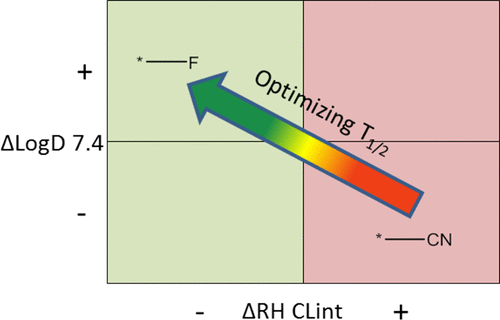当前位置:
X-MOL 学术
›
ACS Med. Chem. Lett.
›
论文详情
Our official English website, www.x-mol.net, welcomes your feedback! (Note: you will need to create a separate account there.)
Why Decreasing Lipophilicity Alone Is Often Not a Reliable Strategy for Extending IV Half-life
ACS Medicinal Chemistry Letters ( IF 4.2 ) Pub Date : 2018-04-19 00:00:00 , DOI: 10.1021/acsmedchemlett.8b00047 Fabio Broccatelli 1 , Ignacio Aliagas 1 , Hao Zheng 1
ACS Medicinal Chemistry Letters ( IF 4.2 ) Pub Date : 2018-04-19 00:00:00 , DOI: 10.1021/acsmedchemlett.8b00047 Fabio Broccatelli 1 , Ignacio Aliagas 1 , Hao Zheng 1
Affiliation

|
The optimization of the pharmacokinetic profile of a drug is one of the crucial aspects of medicinal chemistry campaigns. When efficacy is driven by a continuous coverage of the minimum efficacious plasma concentration, half-life must be optimized to achieve the optimal pharmacokinetic profile. The consensus in the field is that decreasing clearance, as opposed to increasing volume of distribution, is a better strategy to prolong half-life. While both the pharmacokinetic theory and the need for an optimal safety profile support this approach, this needs to be integrated with practical indications concerning the strategy to optimize clearance. This work presents an extensive analysis of Genentech’s in vitro and in vivo rat pharmacokinetic data, which highlights how half-life optimization through simple modulation of lipophilicity is generally not a successful strategy. Decreasing lipophilicity without addressing a metabolic soft-spot will often lead to both lower clearance and lower volume of distribution without extending half-life.
中文翻译:

为什么单独降低亲脂性通常不是延长IV半衰期的可靠策略
药物药代动力学特征的优化是药物化学运动的关键方面之一。当通过连续覆盖最低有效血浆浓度来提高疗效时,必须优化半衰期以达到最佳药代动力学特征。在该领域的共识是,与增加分配量相比,减少清除率是延长半衰期的更好策略。虽然药代动力学理论和对最佳安全性的需求都支持这种方法,但是这需要与有关优化清除率策略的实际适应症相结合。这项工作对Genentech的体外和体内大鼠药代动力学数据进行了广泛的分析,这突显了通过亲脂性的简单调节来优化半衰期通常不是成功的策略。在不解决代谢软斑的情况下降低亲脂性通常会导致清除率降低和分布体积降低,而不会延长半衰期。
更新日期:2018-04-19
中文翻译:

为什么单独降低亲脂性通常不是延长IV半衰期的可靠策略
药物药代动力学特征的优化是药物化学运动的关键方面之一。当通过连续覆盖最低有效血浆浓度来提高疗效时,必须优化半衰期以达到最佳药代动力学特征。在该领域的共识是,与增加分配量相比,减少清除率是延长半衰期的更好策略。虽然药代动力学理论和对最佳安全性的需求都支持这种方法,但是这需要与有关优化清除率策略的实际适应症相结合。这项工作对Genentech的体外和体内大鼠药代动力学数据进行了广泛的分析,这突显了通过亲脂性的简单调节来优化半衰期通常不是成功的策略。在不解决代谢软斑的情况下降低亲脂性通常会导致清除率降低和分布体积降低,而不会延长半衰期。


























 京公网安备 11010802027423号
京公网安备 11010802027423号